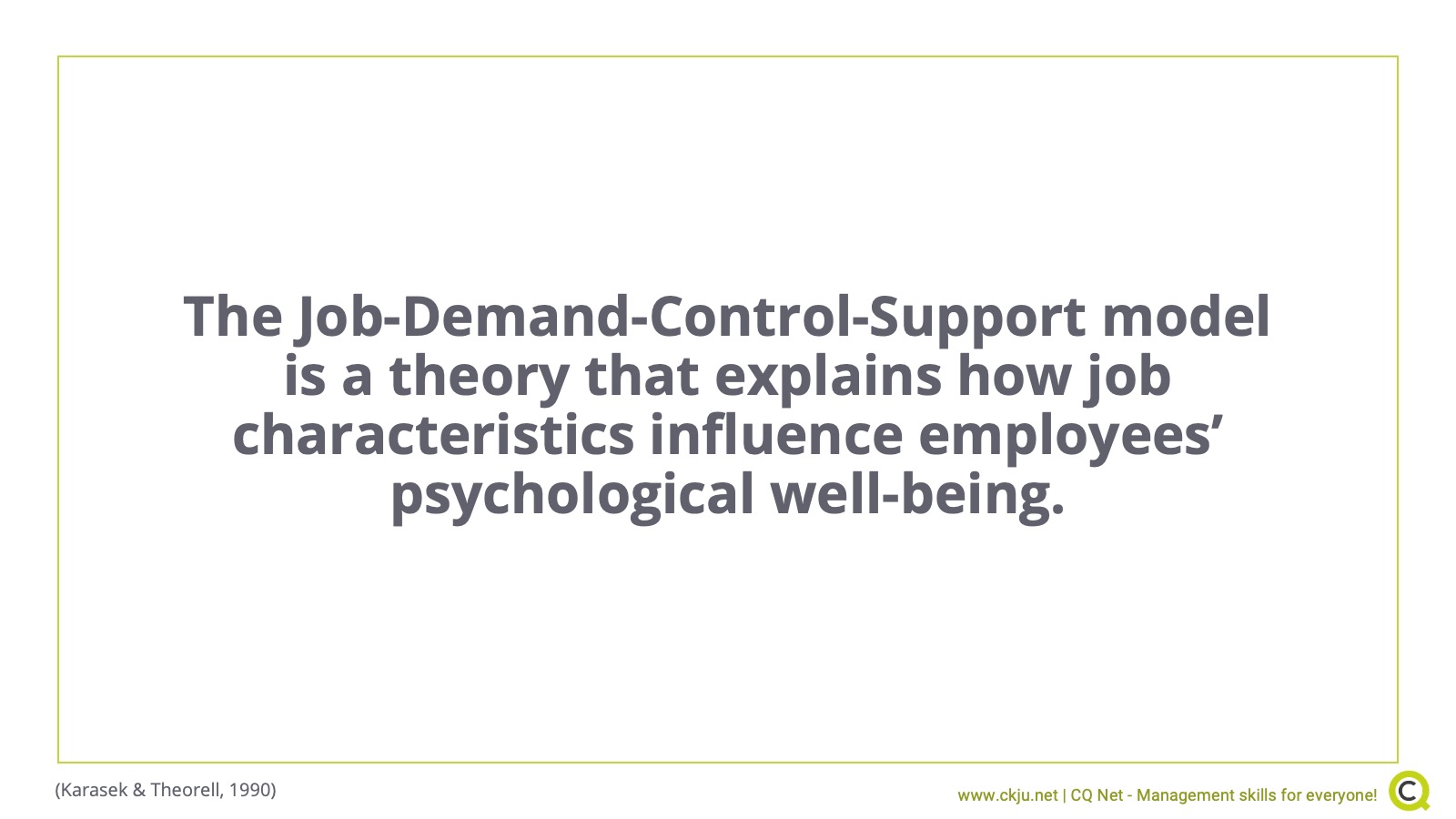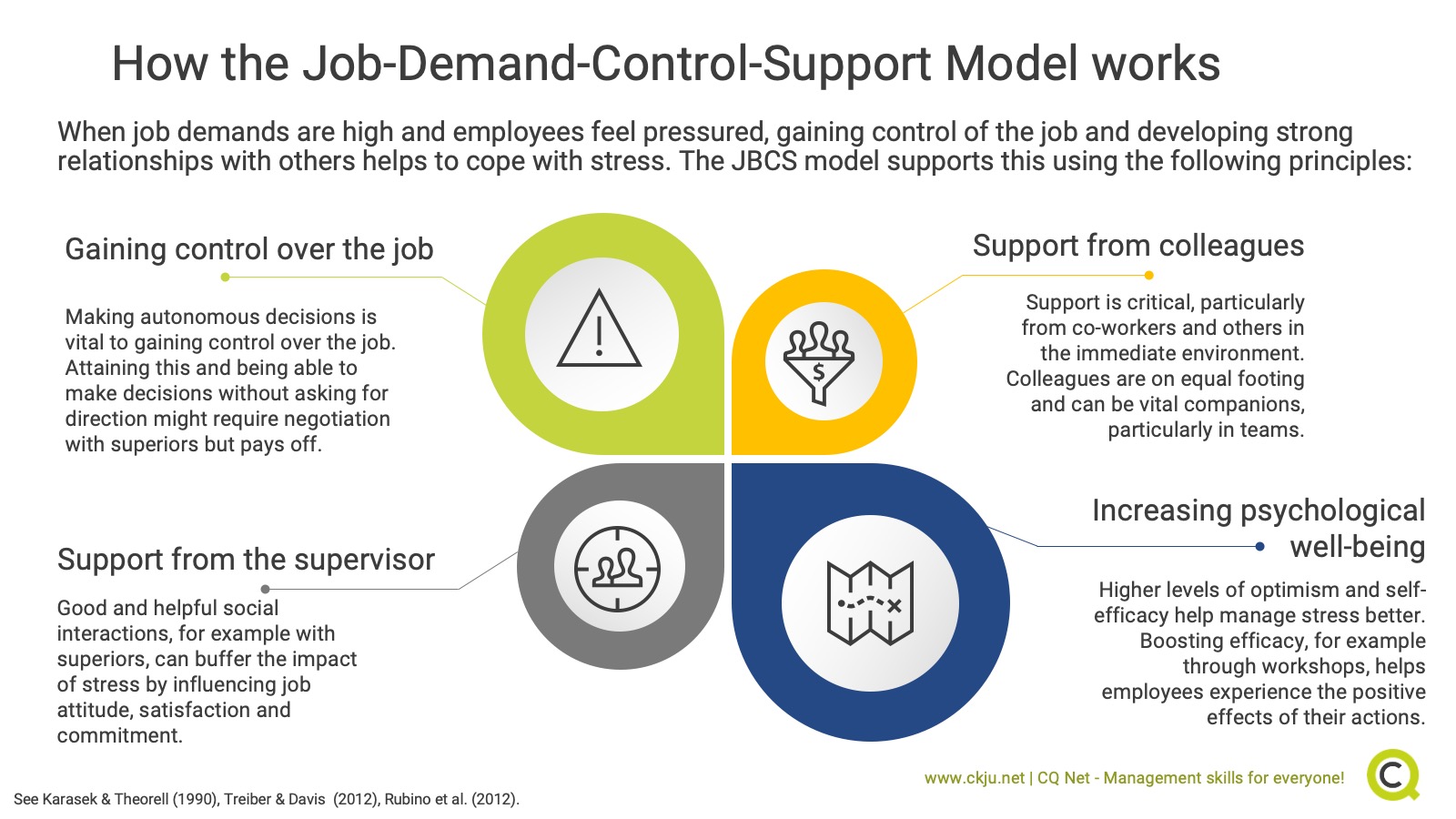- All Management Learning Resources
- Job-Demand-Control-Support Model

Why should you care about the Job-Demand-Control-Support Model?
During these turbulent times, employees are experiencing stress as they manage responsibilities at work and at home. Many people wonder how they can manage and cope with workplace stress. The Job-Demand-Control-Support (JDCS) Model offers insights on how to deal with stress through identifying those situations and individual characteristics that matter in times of stress.
Contents
- Why should you care about the Job-Demand-Control-Support Model?
- What is the Job-Demand-Control-Support model?
- How does the Job-Demand-Control-Support model work?
- What are the benefits of the JDCS model?
- What are the shortcomings of the JDCS model?
- The JCDS Model is a useful management tool
- Critical appraisal of the JDCS model: Solidity Rating 4
- Key recommendations for professionals
- References and further reading
What is the Job-Demand-Control-Support model?
The Job-Demand-Control-Support model is a well-known theory that explains how job characteristics influence employees’ psychological well-being (Karasek & Theorell, 1990). The model illustrates how job demands can cause stress for employees, such as heavy workload, role ambiguity, and job-related strain. However, the model posits that individuals can manage these stressors through utilizing job skills that allow them to gain autonomy and control over their work (Karasek & Theorell, 1990).
How does the Job-Demand-Control-Support model work?
The model works through showing that when employees have high levels of job demands, this creates stress. However, employees can decrease this stress through gaining greater job control and developing strong relationships with their colleagues and supervisor. The JDCS model works when you, as an employee, use the following principles:
Gain control over your job
It is important that you gain autonomy in your job. This can involve making decisions on your own without asking for direction. This might require negotiating with your supervisor on gaining decision latitude in your work. You can obtain guidance from your supervisor on decisions yet still gain freedom in making decisions regarding ways in which to work.
Gain support from your supervisor
It is important to gain support from your supervisor because having helpful social interactions can buffer the impact of stress. Job support is defined as the (p69, Karasek & Theorell, 1990)
“overall levels of helpful social interaction available on the job from both co-workers and supervisors.”
When you have helpful social interactions, this acts as a coping mechanism that helps buffer the impact of stress. Supervisor support can influence your attitude towards your job, including job satisfaction, and commitment; in addition, if you have the support of your supervisor you are less likely to show intention to leave the organization (Ng & Sorenson, 2008). Furthermore, if you work in a firm that is hierarchical, your supervisor can have more influence because their role will be valued in the work environment (Hwang, Lee, & Lee, 2012).
Gain support from your colleagues
Both supervisor and worker support are coping mechanisms to buffer stress. However, they are different because they have different impacts on your well-being. In fact, it is more important to gain support from your coworkers because their support is critical and immediate (Treiber & Davis, 2012). Moreover, the relationship that you have with your coworkers is egalitarian because they are not in a position of power. It can also be a source for companionship and is particularly important during teamwork (Kossek, Pichler, Bodner & Hammers, 2011).
Increase your psychological well-being
Employees cope well with job stressors when they have good physical and psychological health. Employees who have high levels of optimism and self-efficacy tend to do well in managing stress because they believe that they have the capability to cope with work stressors (Rubino et al., 2012). One of the best ways to increase self-efficacy is through mastery experiences (Zimmerman, 2000).
During mastery experience workshops, employees gain boosts to their efficacy because they experience the positive effects of their actions. The workshops provide opportunities for trainees to gain success in handling workplace stressors.
What are the benefits of the JDCS model?
There are various benefits associated with the JDCS model. We will have a look at the most important ones.
The JDCS model provides opportunities for interventions
The JDCS is a useful tool to identify why employees are experiencing stress. There are also a variety of potential interventions. For example, employees can negotiate with management to discuss degree of control latitude if juggling many tasks. If employees feel they have little influence in their job, then they can discuss the possibility of a more active job with management. There are many diverse possibilities.
The JDS model provides opportunities for relationships
Managers can also use the JDCS model to motivate and encourage their subordinates to have a healthy work balance. In fact, it is the role of the manager to speak to their subordinates if there are issues with job performance and an opportunity to formulate join solutions. Management can also use the JDCS model to measure levels of employee satisfaction and motivation ((Ng & Sorenson, 2008).
What are the shortcomings of the JDCS model?
As with every management tool, the JDSC model has some shortcomings. We will provide you an overview of the most important ones in the following section.
It does not work for everyone
The model is supportive for male employees who work in high-stress environments. However, the JDCS is less useful for female employees and suggests that women have different experiences in high-strain jobs (Van Der Doef & Maes, 1999).
The model is effective in the short-term
Another drawback of the model is that the research has been cross-sectional, occurring mainly at one point in time (Van Der Doef & Maes, 1999). Most of the research has supported the model for cross-sectional designs but only provides information on the relationships between factors such as job strain and well-being.
Longitudinal research, whereby measurement occurs over a long period of time, have been conducted; however, these studies have failed to support the model. More research is needed to determine situations in which the model is effective.
The model is effective for workers with high workload
The model is effective for employees who have a high workload, and this is central to the concept of job demands (Karasek & Theorell, 1990). However, many workers do not have high work loads yet experience stress due to other factors.
For example, human services professionals can experience stress due to compassion fatigue when counseling clients and teachers can experience stress if dealing with students who are struggling academically because they have empathy. Again, the model is useful but needs to be adjusted for those with stressors that are not related to workload.
The JCDS Model is a useful management tool
The JCDS Model is a useful model to enable employees and management to consider how to reduce workplace stress. The model can apply to a wide variety of jobs where employees struggle with workload. The model also is useful for developing and implementing interventions that reduce stress through acknowledging how employees can utilize their strengths to minimize strain.
Critical appraisal of the JDCS model: Solidity Rating 4
Based on the importance of JCDS model, this CQ Dossier is assigned a Level 4 rating (Based on a 1- 5 measurement scale). A level 4 is the second highest rating score for a dossier based on the evidence available that supports the JCDS model. The JCDS model can be very useful when professionals seek interventions to help them deal with a high workload. The model works well in most situations yet needs to be adapted for employees who have other work-related stressors.
Key recommendations for professionals
- Gain autonomy in your job. Work with your manager to gain more control in decision-making.
- Lean on your supervisor and colleagues for social support to help buffer work stress.
- Boost your confidence levels through tending to your physical and psychological health.
- Seek opportunities to connect with colleagues for trusting and supportive relationships.
References and further reading
Hwang, W., Lee, S., Lee, N. (2012). Variables influencing on daily parenting stress of employed mothers with nonstandard work schedule. Korean Journal of Family Relations, 17, 87-112.
Karasek, R., & Theorell, T. (1990). Healthy Work: Stress, Productivity, and the Reconstruction of Working Life. New York: Basic Books.
Kossek, E. E., Pichler, S., Bodner, T., Hammer, L. B. (2011). Workplace social support and work-family conflict: A meta-analysis clarifying the influence of general and work-family-specific supervisor and organizational support. Personnel Psychology, 64, 289-313.
Ng, T. W. H., & Sorensen, K. L. (2008). Toward a further understanding of the relationships between perceptions of support and work attitudes: A meta-analysis. Group & Organization Management, 33(3), 243–268.
Rubino, C., Perry, S. J., Milam, A. C., Spitzmueller, C., and Zapf, D. (2012). Demand-control-person: integrating the demand-control and conservation of resources models to test an expanded stressor-strain model. Journal of Occupational Health Psychology. 17, 456–472
Treiber, L. A., Davis, S. N. (2012). The role of “workplace family” support on worker health, exhaustion and pain. Community, Work & Family, 15, 1-27.
van der Doef, M., Maes, S. (1999). The job demand-control (-support) model and psychological well-being: A review of 20 years of empirical research. Work & Stress, 13, 87-114.
Zimmerman, B. (2000). Self-efficacy: an essential motive to learn. Contemporary Educational Psychology, 25, 82–91.
About the Author





